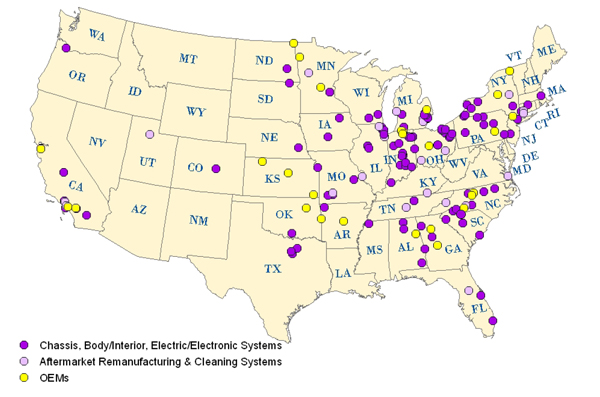Cleaner buses can create jobs, improve the environment
A new study by Duke University illuminates the fact that thousands of green jobs are waiting to be tapped in transit bus manufacturing — if the federal government will make a sustained commitment to investing in public transportation.
The Duke University Center on Globalization, Governance and Competitiveness released a new report this morning during a briefing at the Natural Resources Defense Council that evaluated the many U.S. job opportunities that can reduce carbon emissions in public transit buses. Jobs in and related to public transportation are some of the lowest hanging fruit in the push for green jobs, so what’s keeping the domestic manufacturing industry from ramping up?
The U.S. market for heavy-duty transit buses is small, currently delivering 5,000 to 5,500 buses per year. U.S.-based firms dominate the North American bus market, with an 88% share in total buses and a 51% share in heavy-duty transit buses. Under current U.S. transportation policy, which favors highway spending and de-emphasizes public transit, bus orders are small and sporadic; this makes it difficult for the bus industry to grow.
 |
| Non-comprehensive chart of the domestic supply chain for buses. From the Duke CGGC report, p.30 |
The report is well worth a read, but for a much simpler case study of what this means in real life, consider one piece of the complex supply chain for transit buses that we tend to take for granted: seats. On a crowded bus or train, you may not get the chance to sit in one, but when you do, you probably don’t think about the design or innovation that went into that seat. It probably didn’t occur to you that seats can add hundreds or thousands of pounds of weight that the bus needs energy to carry.
David McLaughlin, vice president of the American Seating Company, a U.S.-based manufacturer of seats for buses and railcars (among many other things), made it clear at this morning’s briefing that increased investment in transit would be good for business. But he also stressed that those benefits are not limited to American Seating alone. As a result of the stimulus bill from 2009, McLaughlin’s company calculated $2.9 million in new business, the bulk of which resulted from seat orders for buses and railcars ordered by transit agencies across the country with stimulus dollars.
“$2.9 million means 11 new jobs for us at American Seating,” he said. In another internal study, His company discovered that 1 job at American Seating sustained roughly 6 others in their immediate supply chain.
Take those two facts together and you begin to see the economic impact of the small public transit investment in the stimulus — and what could happen on a much larger scale. American Seating, just one manufacturer of one particular component that goes into transit vehicles, created the equivalent of 11 jobs through the stimulus. Those 11 jobs create or sustain 66 more at the company that supply them.
Stimulus spending will not be enough, however. Although the economic activity resulting from the stimulus was important, McLaughlin said his business needs investment that is reliable, consistent and predictable — like the funding that could result from a full six-year transportation bill. Stable funding sources will fuel the research and development that can cut seats weights even further and enable buses to use less energy.
“The stimulus package has been a good thing, but what we really need is sustained predictable investment, so we can make the investments we need to make to ensure our viability. This isn’t just a public issue, it’s a public-private issue. …It’s jobs,” he said.
The message from all fronts this morning was consistent. To spur job creation through manufacturing cleaner transit buses, the industry needs reliable, predictable investment and government policies that encourage innovation. Increasing the available federal funding for new transit lines and rolling stock is one aspect. Ensuring operation of these new transit lines remains affordable is another. Both are needed. As the report says:
If federal, state and local policy were to shift to a clear, sustained commitment to public transit, the nation would have the manufacturing capability to meet the resulting increased demand for transit buses. However, the transit bus industry is unlikely to have significant market growth in the absence of several major changes: better management of public transit funds and improved coordination with manufacturing firms; significant, sustained public funding; and perhaps most important, a comprehensive transportation policy shift that encourages public transit use.
Or, in other words, give transit agencies money to buy new rolling stock — and the money to operate them — and you’ll be creating green jobs on Main Street all across America. Buy new hybrid buses for New York City or San Francisco to reduce emissions there, and support new jobs in towns like Grand Rapids, Michigan that need jobs more than anything.




















No Comments